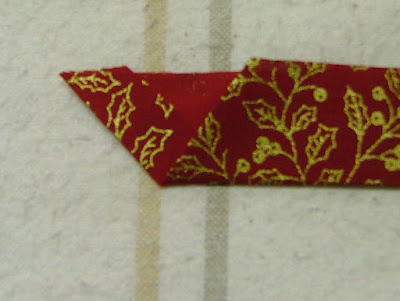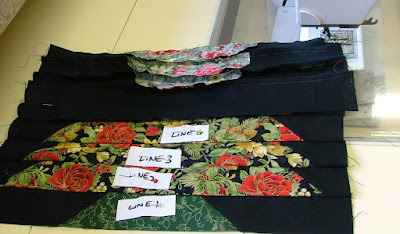BLOG 274
I battled on with the Picket Fence lap quilt, adding a 2 ½” border
all round.
Border
Top with border
I chose a coordinating fabric for the back
Backing
I trimmed some of the off-cut triangles to audition on the
edge but I didn’t think that they added any appeal to the finished top (nothing
to do with the fact that I didn’t have enough and I would have had to prepare
several more!!)
Auditioning triangles
Chivers assisted
I just decided to add wadding and a backing and quilt it
vertically and horizontally in the ditch of the seams. I then used a decorative
stitch and variegated thread to sew round the inner border. Binding completed
the quilt and here it is in situ. I may return to hand quilt more detail on
this quilt over winter; it will be good to have it across my lap to warm me as
I work on it!
In situ
Detail
PROJECT: CHRISTMAS
TREE WALL HANGING 15” x 18” (or 18” x 21” with borders)
This machine-pieced wall hanging will make a welcome
addition to your Christmas decorations. It is easy to make so it could also be
made as a gift for special people. Simple construction techniques are used, and
as long as you work in a logical way, it goes together fine, with no matching
of awkward angles. (NB this wall hanging is not original to me; I cannot remember
who designed it originally to acknowledge them, so sorry about that.)
Simple
With borders
REQUIREMENTS
Tree trunk: 2” x
7” green strip
Background: fat
quarter
Tree: ½ m
Christmas fabric
Star: 3 ½” square
of both gold fabric and fusible
Low loft wadding:
20” x 24” (includes border)
Backing fabric:
20” x 24” (includes border)
Sewing machine:
with a dark neutral thread, ready to sew a straight stitch.
General sewing kit:
with pins, scissors, ruler and marking tool
PREPARATION The
success of the wall hanging starts here! These strips need to be accurately cut
and labelled.
Cut the following strips accurately and pin them together as
lines with the appropriate label.
Cut and label the strips
LINE 1: tree
trunk: cut 2”x7” green, background: 2 strips of 2” x 6”
LINE 2: tree: 2”
x 14”, background: 2 strips of 2” x 2 ½”
LINE 3: tree 2” x
13”, background: 2 strips of 2” x 3”
LINE 4: tree 2” x
12” background: 2 strips of 2” x 3 ½”
LINE 5: tree 2” x
11” background: 2 strips of 2” x 4”
LINE 6: tree 2” x
10” background: 2 strips of 2” x 4 ½”
LINE 7: tree 2” x
9” background: 2 strips of 2” x 5”
LINE 8: tree 2” x
8” background: 2 strips of 2” x 5 ½”
LINE 9: tree 2” x
7” background: 2 strips of 2” x 6”
LINE 10: tree 2”
x 6” background: 2 strips of 2” x 6 ½”
LINE 11: tree 2”
x 5” background: 2 strips of 2” x 7”
LINE 12:
background 2” x 15”
METHOD
For lines 1 to 11: place the 2 background strips, with RS together,
on either side of the tree fabric as shown. Mark a sewing line from the top corner of the
background fabric diagonally to the bottom corner of the tree fabric.
Mark sewing lines
Sew along the marked lines and trim away the excess fabric
at the corner.
Sew and trim
Place the lines back in sequence once they are completed. More
next week!
Sequence



















































